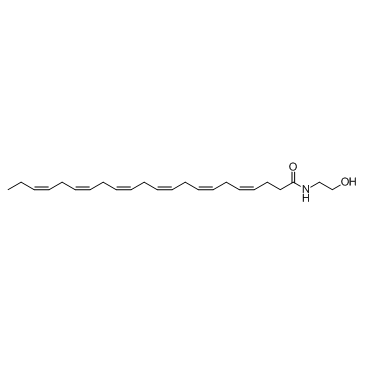Synaptamide
Modify Date: 2025-08-26 20:03:31

Synaptamide structure
|
Common Name | Synaptamide | ||
|---|---|---|---|---|
| CAS Number | 162758-94-3 | Molecular Weight | 371.556 | |
| Density | 1.0±0.1 g/cm3 | Boiling Point | 544.7±50.0 °C at 760 mmHg | |
| Molecular Formula | C24H37NO2 | Melting Point | N/A | |
| MSDS | Chinese USA | Flash Point | 283.3±30.1 °C | |
Use of SynaptamideSynaptamide is a potent mediator for neurogenic differentiation of NSCs acting through PKA/CREB activation.Target: in vitro: Synaptamide inhibits forskolin-mediated cAMP production (IC50 =6 μM) in CHO-HCR cells. Synaptamide decreases the viability of the LNCaP and PC3 prostate cancer cell lines (IC50=120-130 μM) grown in media containing 10% fetal bovine serum. [1] Synaptamide is an endogenous DHA metabolite with endocannabinoid-like structure, promotes neurite growth, synaptogenesis and synaptic function. Synaptamide potently induces neuronal differentiation of NSCs. Treatment of NSCs with Synaptamide at low nanomolar concentrations significantly increased the number of MAP2 and Tuj-1 positive neurons with concomitant induction of PKA/CREB phosphorylation. [2] |
| Name | Docosahexaenoyl ethanolamide |
|---|---|
| Synonym | More Synonyms |
| Description | Synaptamide is a potent mediator for neurogenic differentiation of NSCs acting through PKA/CREB activation.Target: in vitro: Synaptamide inhibits forskolin-mediated cAMP production (IC50 =6 μM) in CHO-HCR cells. Synaptamide decreases the viability of the LNCaP and PC3 prostate cancer cell lines (IC50=120-130 μM) grown in media containing 10% fetal bovine serum. [1] Synaptamide is an endogenous DHA metabolite with endocannabinoid-like structure, promotes neurite growth, synaptogenesis and synaptic function. Synaptamide potently induces neuronal differentiation of NSCs. Treatment of NSCs with Synaptamide at low nanomolar concentrations significantly increased the number of MAP2 and Tuj-1 positive neurons with concomitant induction of PKA/CREB phosphorylation. [2] |
|---|---|
| Related Catalog | |
| References |
| Density | 1.0±0.1 g/cm3 |
|---|---|
| Boiling Point | 544.7±50.0 °C at 760 mmHg |
| Molecular Formula | C24H37NO2 |
| Molecular Weight | 371.556 |
| Flash Point | 283.3±30.1 °C |
| Exact Mass | 371.282440 |
| PSA | 49.33000 |
| LogP | 5.44 |
| Vapour Pressure | 0.0±3.3 mmHg at 25°C |
| Index of Refraction | 1.521 |
| InChIKey | GEEHOLRSGZPBSM-KUBAVDMBSA-N |
| SMILES | CCC=CCC=CCC=CCC=CCC=CCC=CCCC(=O)NCCO |
| Storage condition | -20°C |
| RIDADR | NONH for all modes of transport |
|---|
| 4,7,10,13,16,19-Docosahexaenamide, N-(2-hydroxyethyl)-, (4Z,7Z,10Z,13Z,16Z,19Z)- |
| (4Z,7Z,10Z,13Z,16Z,19Z)-N-(2-Hydroxyethyl)docosa-4,7,10,13,16,19-hexaenamide,DEA,DHEA |
| (4Z,7Z,10Z,13Z,16Z,19Z)-N-(2-Hydroxyethyl)-4,7,10,13,16,19-docosahexaenamide |
| N-(2-hydroxyethyl)docosa-4,7,10,13,16,19-hexaenamide |
| Synaptamide |